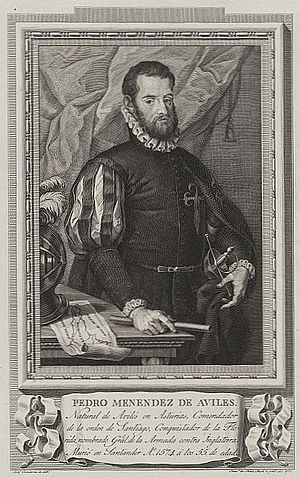Pedro Menéndez de Avilés
| Pedro Menéndez de Avilés | |
|---|---|

Pedro Menéndez de Aviles
|
|
| 1st Governor of Florida | |
|
In office 1565–1574 |
|
| Succeeded by | Diego de Velasco |
| Personal details | |
| Born |
15 February 1519 Avilés, Asturias, Spain |
| Died | 17 September 1574 (aged 55) Santander, Cantabria, Spain |
| Nationality | Spanish |
| Occupation | Admiral; 16th-century colonial governor of La Florida and Cuba, in New Spain |
| Religion | Roman Catholic |
Pedro Menéndez de Avilés (15 February 1519 – 17 September 1574) was a Spanish admiral and explorer from the region of Asturias, Spain, who is remembered for planning the first regular trans-oceanic convoys and for founding St. Augustine, Florida, in 1565. This was the first successful Spanish settlement in La Florida and the most significant city in the region for nearly three centuries. St. Augustine is the oldest continuously-inhabited, European-established settlement in the continental United States. Menéndez de Avilés was also the first governor of Florida (1565–74).
Menéndez had made his career in the Spanish Navy, in the service of the king, Philip II of Spain. His initial plans for a voyage to Florida revolved around searching for his son, Juan, who had been shipwrecked there in 1561. He could not find his son and he was assumed dead.
Following the founding of Fort Caroline in present-day Jacksonville by French Huguenots under René Goulaine de Laudonnière, he was commissioned to conquer the peninsula as Adelantado. He established Saint Augustine, or San Agustín, in 1565; then he seized Fort Caroline and displaced the French.
His position as governor now secure, Menéndez explored the area and built additional fortifications. He returned to Spain in 1567 and was appointed governor of Cuba, in October of that year. He voyaged to La Florida for the last time in 1571, with 650 settlers for Santa Elena, as well as his wife and family. Menéndez died at Santander, Spain, in 1574.
...
Wikipedia
